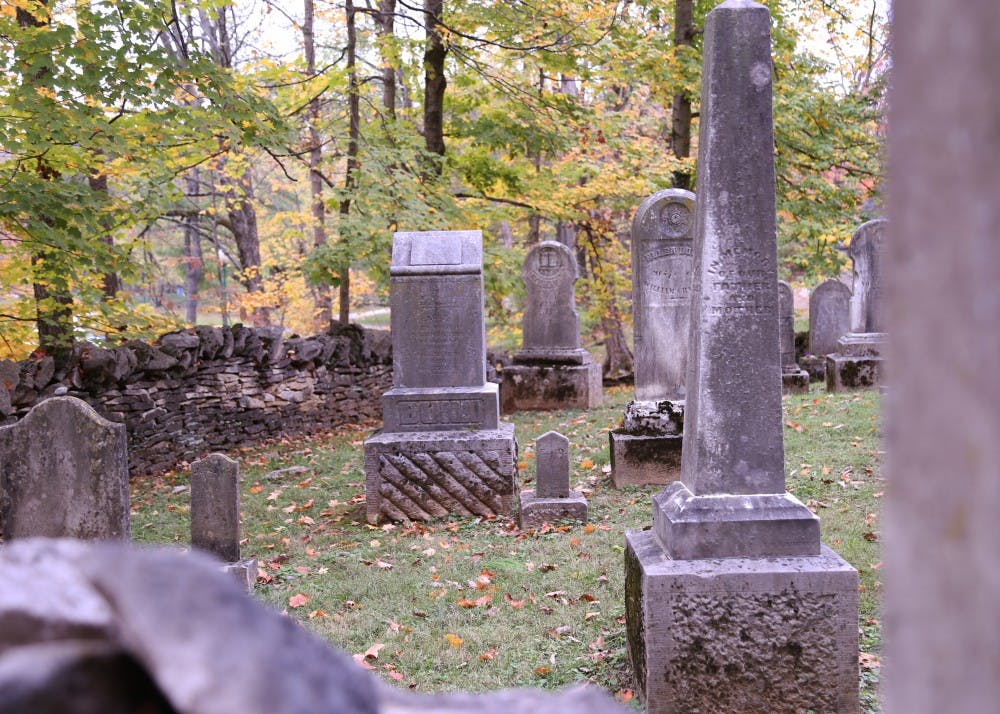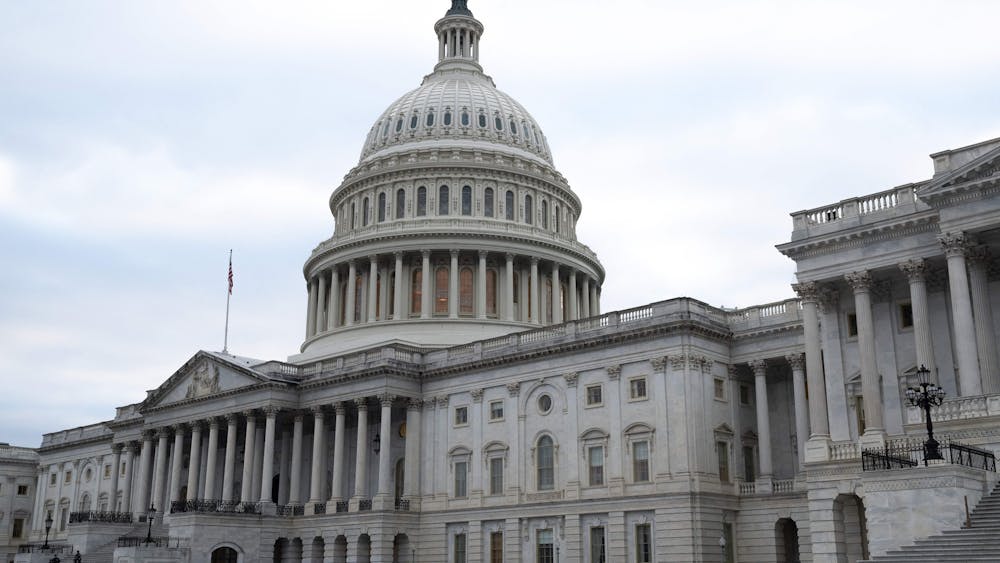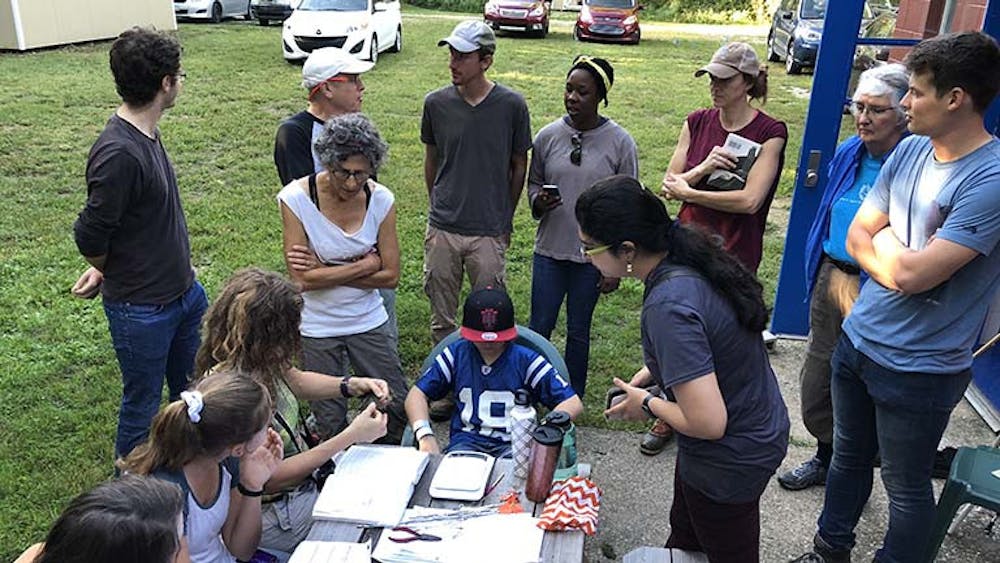Situated on a patch of land overlooking the Jordan River, one family is laid to rest in the heart of IU’s campus.
Dunn Cemetery sits beside the Indiana Memorial Union. Students walk by on their way to class every day, and usually do not know what is it or how the cemetery got there.
Three sisters, Elinor Brewster Dunn, Agnes “Nancy” Brewster Alexander and Janet Brewster Irvin began the cemetery’s story.The Brewster sisters provided resources for the American army toward the end of the war, originally living in Virginia during the Revolutionary War.
After the war, they eventually all moved to Bloomington, where they settled and died, according to IU Archives on the cemetery’s history.
They were buried in the Dunn's family cemetery, a plot of land on the Dunn family’s farm in what was then east Bloomington. The last Brewster sister, Elinor, died in 1841 in Bloomington.
One of Elinor’s grandsons, farmer turned U.S. congressman George Grundy Dunn, deeded the 60-by-110 feet plot of land forever a cemetery plot in honor of his grandmother and her two sisters. They laid to rest there.
In 1883, George Grundy Dunn’s son, Moses Fell Dunn, sold the acreage surrounding the cemetery to the trustees of IU. A condition of the sale was the graveyard had to be preserved, and untouched by non-family members forever.
Today, there are only two IU graduates who are direct descendants of two of the Brewster sisters. One of them, Stephen Hofer, said only direct descendants of the three Brewster sisters are allowed to be buried there. It was a provision of the sale made by the Dunns, and the University has kept true to its promise.
“Those of us who are connected to it are very proud of it and very proud of both our relationship with those ancestors and also our relationship with the university.” Hofer said.
Hofer, an attorney raised in Indiana, now based in California, said he became interested in genealogy around 2000.
As an IU student, he had walked past the cemetery, but never really realized its personal significance, though his family had talked about the Dunn history before.
“I would walk by that cemetery on the way to class in Ballantine or Woodburn and I would sort of think, ‘Yeah, I’m related to people in that cemetery,’” Hofer said. “But it didn’t resonate in a meaningful way to me.”
Once he began to learn amateur genealogy, however, he figured out he was not only a direct descendant of two of the Brewster sisters, but his 8th great grandfather settled in Jamestown.
His interest in genealogy matched up with another amateur genealogist, Larry Stephens, IU's director of insurance, loss control and claims.
All burial requests that the University receives must be approved by Stephens. A vigorous process, funneled from Stephens to Hofer, must take place before anyone requesting a plot in the cemetery can rest there.
“He’s very particular,” Stephens said of Hofer. “He’s very meticulous about documentation and they have to show they have a link back to the family.”
When Hofer receives a request to be buried in the cemetery, he takes a look at what they provide him, going back generation by generation making sure there is a true direct link to the sisters through records and other documentation of their families.
He began taking requests and verifying them when Stephens reached out to him in 2006, after the previous person of contact for requests died. Stephens said they were having trouble finding someone, but happened upon Hofer.
He says he’s been told he is the genealogical caretaker of the Dunn Family Cemetery.
“I get probably, maybe one or two requests a year,” Hofer said. “I’ve approved more than half of them.”
The last person buried there was Hunter Wroblewski, an IU alum who died a little over a year ago in a car accident in Florida.
Stephens said as of now he has three or four spots marked for cremains, and one spot, Wroblewski’s, marked for remains. But there may only be between 10 and 12 spots left, which is why such a meticulous process is necessary.
“It can be difficult,” Stephens said. “Some people just don’t have the evidence that links them.”
But the Brewster-Dunn-Alexander family connections spread far and wide. Many descendants of the Brewster sisters, the Dunns and later on Alexanders and Maxwells contributed to the beginnings of the state of Indiana, according to IU Archive records and Hofer.
“The Dunn name is important in Bloomington,” Hofer said. “The Dunn-Brewster-Alexander family was very prominent in the founding of Bloomington, the University, other state colleges, and very active in both state and national politics.”
Some notable descendents of Elinor and Samuel, Elinor’s husband from which she gained the name Dunn, played roles in Indiana politics leading up the civil war, according to Hofer.
George Grundy Dunn, who dedicated the cemetery, served in Congress from 1847-1849 and then again from 1855-1857.
David Hervey Maxwell, who helped write the Indiana state constitution, is acknowledged as the father of IU. He passed a bill to make IU a state university in 1820, and served as a founding trustee. Maxwell Hall is named in his honor.
The cemetery is maintained informally for the most part, with the exception of the IU grounds crew, led by university landscape architect Mia Williams, mowing the area once or twice a year, Stephens said.
Walking around downtown Bloomington, you see Dunn Street, Dunn Meadow and Dunn Woods. It all links back this quiet little cemetery plot that often goes unnoticed, untouched and hardly visited.
“It’s the place literally from which Indiana University sprang,” Hofer said. “That’s why it’s such an important part of the university.”






